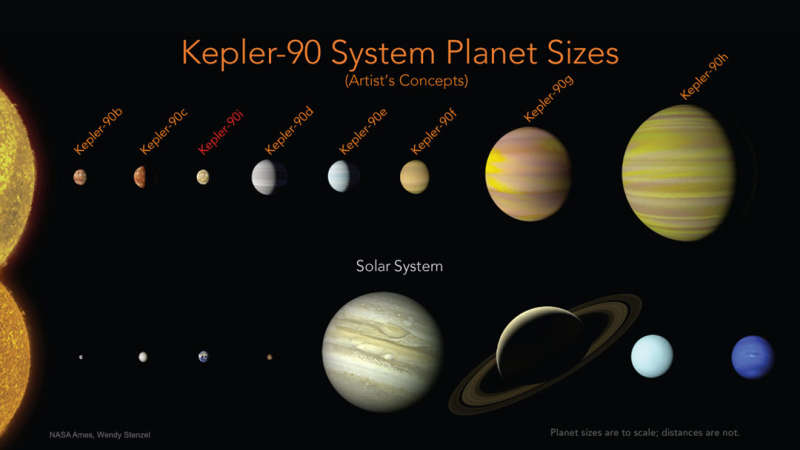Credit & Copyright: NASA Ames, Wendy Stenzel
Explanation:
Do other stars have
planetary systems like our
own?
Yes -- one such system is
Kepler-90.
Cataloged by the
Kepler satellite that operated from Earth orbit between 2009 and 2018,
eight planets were discovered, giving Kepler-90
the same number of known planets as our
Solar System.
Similarities between Kepler-90 and our system include a
G-type star comparable to our Sun, rocky planets comparable to our Earth,
and large planets comparable in size to
Jupiter and
Saturn.
Differences include that all of the known
Kepler-90
planets orbit relatively close in -- closer than
Earth's orbit around the Sun -- making them possibly too hot to
harbor life.
However, observations over longer time periods may discover
cooler planets further out.
Kepler-90 lies about 2,500
light years away, and at magnitude 14 is visible with a medium-sized telescope toward
the constellation of the Dragon
(Draco).
The
exoplanet-finding mission
TESS was launched in 2018, while
missions with exoplanet finding capability planned for launch in the next decade
include
NASA's
JWST and
WFIRST.
Experts Debate:
How will humanity first
discover extraterrestrial life?
1999 2000 2001 2002 2003 2004 2005 2006 2007 2008 2009 2010 2011 2012 2013 2014 2015 2016 2017 2018 2019 2020 2021 2022 2023 2024 2025 |
Январь Февраль Март Апрель Май Июнь Июль Август Сентябрь Октябрь Ноябрь Декабрь |
NASA Web Site Statements, Warnings, and Disclaimers
NASA Official: Jay Norris. Specific rights apply.
A service of: LHEA at NASA / GSFC
& Michigan Tech. U.
|
Публикации с ключевыми словами:
extrasolar planet - экзопланета
Публикации со словами: extrasolar planet - экзопланета | |
См. также:
Все публикации на ту же тему >> | |
